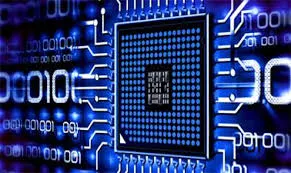Block Diagram of Computer and Its Computer :- The basic configuration of a computer system is as follow : A computer systemin composed of a CPU (Control processing Unit) , a keyboard, a visual display unit (VDU), peripheral devices and operating system (OS). A computer consists of the following parts:
1. Input Unit. 2. Central Processing Unit. 3. Output Unit. 4. Memory. The study of anatomy of a computer is related to the of above mentioned units.
(1) Input Unit
An Input unit is a device which accepts instructions and data from the user and communicates these to the computer. The instructions and data must be presented to the computer in binary language, the only language understood by the machine, so that it is able to understand and execute these instructions. Fortunately, the instructions and data are coded in binary language by the input-devices and not by the users. A computer system, depending upon its requirements, may use one or more of the input-devices, like: keyboard, mouse, card reader, bar code reader, scanner, touchscreen, etc.
Input units have direct access to the central processing unit.
(2) Central Processing Unit (CPU)
The Central Processing Unit of a computer performs all the arithmetic takes, the logical decisions and controls the activities of all the others units. It also houses the storage devices. The central processing unit has therefore rightly been called the heart and nervous central of a computer In order to perform the above mentioned functions, the CPU must have following sub-units:
(I) Control & Timing Unit (CTU) (II) Arithmetic & logical Unit (ALU)
(I) Control & Timing Unitistor : It is the most complex unit and work as a Traffic police. It generates the timing and control signal for performing various micro operations. In the supervision of control unit the following work are done.
(1). It fetches (read from input) the instruction from the input data bus. (2). It places the address of instruction on address bus. (3). It send the instruction to the decoding circuitry for decoding. (4). It reads Address, opcode & operand (data) from memory because all are necessary for instruction execution. (5). It sent the each part of instruction to relevent section like data and address to relevent section. (6). It send result to memory or some other regiser for storing. (7). For fetching the whole program it increment or decrement the program counter.
(II) Arithmetic & Logical Unit (ALU) : As the name indicates that perform all arithmetic operation like add, subtract, multiply, divide etc. as well as all logical operation like compare , shift rotate, AND,OR etc.
(a)- Adder: The circuit specially designed for adding two number and giving result. (b)- Accumulator : It is the most frequently used register for calculation . This registor holds the initial data to be operated upon , the intermediate result and also the final result of processing operation . (c)-General purpose / scratch pad Register: There Register store data and intermediate result during the execution of a program . (d)-Counter : Counter is a special kind of , designed to count the number of clock pulses arriving at its input .

.jfif)

.jfif)
.jfif)
Post a Comment